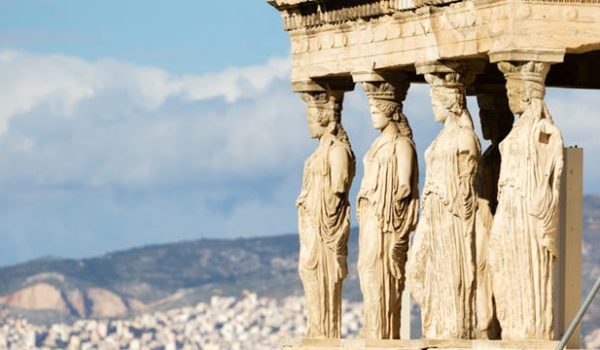There are two main reasons I have chosen Botticelli to be my artist for April: the first is that recently it feels as if spring has finally sprung, despite the odd flurry of snow, therefore one of his most famous works, Primavera, is perfect for this time of year. The second reason is that if you knew me during high school you’ll know that another one of Botticelli’s most famous works, The Birth of Venus, is probably one of my favourite paintings to talk about.
Sandro Botticelli was born in 1445 and spent the majority of his life in Florence. He’s considered to be one of the most well-known Italian painters of the early Renaissance. Both Primavera and The Birth of Venus, his two most popular paintings, are of mythological subjects, however, he also painted religious scenes. After his death, he was relatively unknown until his works were rediscovered in the late nineteenth century when he became a source of great inspiration and influence on pre-Raphaelite artists.
I’ll start by talking about Primavera as it seems more relevant to the current time of year. It depicts a group of figures from classical mythology although, interestingly, no story off which this painting may be based can be found. It’s generally considered to be an allegory of the coming of springtime, although it was first referred to as Primavera by Vasari, an art historian, in 1550.
The painting shows six female figure, two male figures and cupid in an orange grove. From right to left the characters appear as follows: Zephyrus, representing the spring wind; Chloris, a nymph who is kidnapped by Zephyrus; when Zephyrus and Chloris marry he transforms her into the goddess of spring, Flora, who is the next figure along. Next to Flora, a little off centre and further back from the other figures stands Venus, above her flies a blind-folded cupid. To the left are the Three Graces, dancing, and on the far left is Mercury, the messenger god. The elaborate painting depicts around 500 plant species and about 190 different flowers.
The order of the figures, from right to left, depict the progress of the spring season. On the far right we see Zephyrus, the winds of March, blowing on the land and bringing forth growth of plant life and flowers, presided over by Flora and Venus, the goddess of April. On the left is Mercury, the god of May, you can see his outstretched hand is pushing away the final clouds before summer.
The Three Graces represent Pleasure, Chastity and Beauty, and it is thought that Cupid is aiming his arrow at Chastity. The impact of love on Chastity leads to marriage and as Chastity looks towards Mercury some interpret the two as a couple to balance Zephyrus and Chloris on the opposite side of the painting.
There is a lot of controversy surrounding the painting, with scholars arguing over different interpretations of who the figures are meant to represent and what the overall message of the painting is. The figure of Flora is sometimes believed to be Primavera, a personification of Spring, and that the central figure is not Venus, but Persephone.
Regardless, the painting is perfect for this time of year, in my opinion. Remembering the beauty of nature and revelling in the blooming springtime is at least enough to temporarily forget about all my deadlines and exams in the next few weeks
Now I’ll move onto perhaps one of the most famous paintings of the Renaissance, perhaps even of all time: The Birth of Venus. This size and prominence of a female nude figure were practically unheard of in art before this piece While Primavera requires significant analysis to interpret the meaning behind the painting, The Birth of Venus is fairly clear, it does what it says on the tin if you will.
The Greek myth of Venus’ birth has her rising out of the ocean in a giant scallop shell as a fully grown woman. On the left, we have two figures, both deities of wind, blowing Venus to shore. The figure on the right is considered to be one of the three Horae, minor goddesses of Greek mythology representing the seasons and other divisions of time, as well as being the attendants of Venus. The hora waits on the shore with a robe, awaiting Venus’ arrival.
Although Primavera and The Birth of Venus are not obviously connected, nor are they part of a group of paintings meant to be displayed together, they are still intrinsically linked through the prevalence of springtime in each. As previously mentioned, Venus, the goddess of April, is the central figure in both paintings. Furthermore, there is a prominent place given to flowers and plants in both pieces.
You may also notice, looking at both of these paintings, that Botticelli apparently only ever met one woman in his entire life. Or, at least, one woman whose face he managed to represent in paint. And now we come to what really interests me about these paintings: the depiction of the female figure and how it represents beauty standards of the time. I’ll try not to bore you with all the ins and outs of the female nude in paintings, but it’s what really got me so interested in the History of Art in the first place.
Each of the female figures in the Botticelli paintings we’ve seen today has looked very similar. Botticelli’s depiction of women is idealistic and unnaturally beautiful. The pale skin and plump figure are both indicators of the aristocracy, rich women did not have to engage in manual labour under the hot Mediterranean sun. The style and colour of Venus’ hair were also fashionable in late fifteenth-century Italy.
If you look closer at the figure of Venus from The Birth of Venus you might even notice the unnatural curve of her neck and shoulders. It is one thing to portray a goddess as a being of divine beauty, it is another to show her with unnatural bodily composition and bone placement. This depiction perpetuates the patriarchal desire for women to be unnaturally and unattainably beautiful, a problem still prevalent in today’s society and media.
I wish everyone the very best of luck with deadlines and exams coming up and the main purpose of this article, I suppose, is to remind you to take some time for yourself. Perhaps go for a walk or roll around in a field or something. Take a small moment to revel in the joy and beauty of nature and springtime, and don’t think too hard about societally imposed patriarchal beauty standards.










Comments